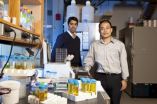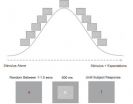(Press-News.org) La Jolla, CA, February 2, 2011 – Embargoed by the journal Science until February 3, 2011, 2 PM, Eastern time - A team of scientists at The Scripps Research Institute has discovered a new way to stabilize proteins — the workhorse biological macromolecules found in all organisms. Proteins serve as the functional basis of many types of biologic drugs used to treat everything from arthritis, anemia, and diabetes to cancer.
As described in the February 4, 2011 edition of the journal Science, when the team attached a specific oligomeric array of sugars called a "glycan" to proteins having a defined structure, the proteins were up to 200 times more stable in the test tube. In the body, this stability may translate into longer half-lives for therapies, possibly lowering the overall cost of treatment for certain protein-based drugs and requiring patients to have fewer injections during a course of treatment.
The work may have major implications for the drug industry because there are a large number of protein-based drugs on the market, more in clinical trials, and many more under development worldwide. Nearly all of these protein-based drugs have glycans attached to them and are therefore called "glycoproteins". Glycoprotein-based drugs can be quite expensive to produce and usually need to be administered intravenously.
One of the challenges in producing these drugs has been increasing their stability, which generally extends their half-life in the bloodstream — issues that the new discovery appears to address directly.
"We've now provided engineering guidelines for glycoprotein stability," said Scripps Research Professor Jeffery W. Kelly, who is chair of the Department of Molecular and Experimental Medicine, Lita Annenberg Hazen Professor of Chemistry, and member of The Skaggs Institute for Chemical Biology at Scripps Research. Kelly led the study with Scripps Research Associate Professor Evan Powers and Staff Scientist Sarah R. Hanson, in collaboration with Research Associates Elizabeth K. Culyba, Joshua Price, and colleagues.
In Search of Stability
Making therapeutic proteins more stable by attaching glycans to them is nothing new. Scientists have known for many years that the human body widely modifies proteins in this way after they are made inside cells. By some estimates, as many as a third of all types of proteins in the human body are "glycosylated," the scientific name for the process whereby glycans are attached to proteins. Scientists also know that these modifications can be directly linked to protein stability.
Attaching a glycan to one part of a protein can have a dramatic stabilizing effect, accounting for the difference between it lasting in the bloodstream for a few minutes or a few days. But attaching the same glycan to another part of the same protein can have a distinctly different destabilizing effect, turning it into the microscopic equivalent of a cooked egg — unfolded and worthless as a medicine.
Scientists who work on these sorts of drugs often try to stabilize their therapeutic proteins with glycans, but until now nobody understood the rules that govern the process — nobody even knew for sure if there were general rules governing it. Researchers have always made such modifications through trial-and-error — more of a time-consuming art than an exact science.
But now, predicts Powers, "Having a rational design approach will streamline protein drug optimization quite a bit."
Simple Engineering Rules
The new research shows simple engineering rules do exist for achieving stability of glycoproteins in the test tube. In the new paper, the Scripps Research team showed that scientists could dramatically stabilize proteins by integrating the standard N-glycan into a particular part of the protein — a structure known as a "reverse turn" containing a certain combination of amino acids. Reverse turns are found in the vast majority of proteins, making this methodology broadly applicable.
The scientists tested their ability to increase the stability of proteins by creating glycoproteins from proteins that are not normally glycosylated — leading to increased stabilization in the test tube. These scientists have not yet looked at how long the proteins survive in the bloodstream — that work is currently under way. But the team is confident that the principles they discovered will now give scientists a new way to predictably stabilize proteins by design.
Kelly added that this portable stabilizing structural module called the "enhanced aromatic sequon" also leads to more efficient production of glycoproteins by cells, a result that is potentially very important, since glycoproteins remain difficult to produce and purify.
###
In addition to Kelly, Powers, Hanson, Culyba, and Price, the article, "Protein Native-State Stabilization by Placing Aromatic Side Chains in N-Glycosylated Reverse Turns" is authored by Apratim Dhar, Chi-Huey Wong, and Martin Gruebele.
This work was supported in part by the Skaggs Institute for Chemical Biology and the Lita Annenberg Hazen Foundation, and funded through grants from the National Institutes of Health and the National Science Foundation.
About The Scripps Research Institute
The Scripps Research Institute is one of the world's largest independent, non-profit biomedical research organizations, at the forefront of basic biomedical science that seeks to comprehend the most fundamental processes of life. Scripps Research is internationally recognized for its discoveries in immunology, molecular and cellular biology, chemistry, neurosciences, autoimmune, cardiovascular, and infectious diseases, and synthetic vaccine development. An institution that evolved from the Scripps Metabolic Clinic founded by philanthropist Ellen Browning Scripps in 1924, Scripps Research currently employs approximately 3,000 scientists, postdoctoral fellows, scientific and other technicians, doctoral degree graduate students, and administrative and technical support personnel. Headquartered in La Jolla, California, the institute also includes Scripps Florida, whose researchers focus on basic biomedical science, drug discovery, and technology development. Scripps Florida is located in Jupiter, Florida. For more information, see www.scripps.edu.
Scripps Research scientists develop powerful new methodology for stabilizing proteins
Work may have broad implications for drug development
2011-02-04
ELSE PRESS RELEASES FROM THIS DATE:
Princeton scientists discover mechanism involved in breast cancer's spread to bone
2011-02-04
In a discovery that may lead to a new treatment for breast cancer that has spread to the bone, a Princeton University research team has unraveled a mystery about how these tumors take root.
Cancer cells often travel throughout the body and cause new tumors in individuals with advanced breast cancer -- a process called metastasis -- commonly resulting in malignant bone tumors. What the Princeton research has uncovered is the exact mechanism that lets the traveling tumor cells disrupt normal bone growth. By zeroing in on the molecules involved, and particularly a protein ...
Boosting body's immune response may hold key to HIV cure
2011-02-04
Australian scientists have successfully cleared a HIV-like infection from mice by boosting the function of cells vital to the immune response.
A team led by Dr Marc Pellegrini from the Walter and Eliza Hall Institute showed that a cell signaling hormone called interleukin-7 (IL-7) reinvigorates the immune response to chronic viral infection, allowing the host to completely clear virus. Their findings were released in today's edition of the journal Cell.
Dr Pellegrini, from the institute's Infection and Immunity division, said the finding could lead to a cure for chronic ...
Expectations speed up conscious perception
2011-02-04
The human brain works incredibly fast. However, visual impressions are so complex that their processing takes several hundred milliseconds before they enter our consciousness. Scientists at the Max Planck Institute for Brain Research in Frankfurt am Main have now shown that this delay may vary in length. When the brain possesses some prior information − that is, when it already knows what it is about to see − conscious recognition occurs faster. Until now, neuroscientists assumed that the processes leading up to conscious perception were rather rigid and that ...
Northern hunters slowed down advance of Neolithic farmers
2011-02-04
One of the most significant socioeconomic changes in the history of humanity took place around 10,000 years ago, when the Near East went from an economy based on hunting and gathering (Mesolithic) to another kind on agriculture (Neolithic). Farmers rapidly entered the Balkan Peninsula and then advanced gradually throughout the rest of Europe.
Various theories have been proposed over recent years to explain this process, and now physicists from the University of Girona (UdG) have for the first time presented a new model to explain how the Neolithic front slowed down as ...
Adapting technology to elderly people
2011-02-04
Massive Art Multimedia in Austria and CoSi Elektronik in Germany have a history of collaboration on successful technical projects. A brainstorming session between their developers produced the idea of bringing together many aspects of the modern computing world and applying them specifically to the one group in society that is least likely to already feel those benefits - senior citizens. As with so many projects of this nature, the funding for development was out of reach of two SMEs. By facilitating the funding process EUREKA permitted the development of the project now ...
Death in the bat caves: Disease wiping out hibernating bats
2011-02-04
Conservationists across the United States are racing to discover a solution to White-Nose Syndrome, a disease that is threatening to wipe out bat species across North America. A review published in Conservation Biology reveals that although WNS has already killed one million bats, there are critical knowledge gaps preventing researchers from combating the disease.
WNS is a fatal disease that targets hibernating bats and is believed to be caused by a newly discovered cold-adapted fungus, Geomyces destructans, which infects and invades the living skin of hibernating bats. ...
Using a generic blood pressure and heart drug could save the UK $324 million in 2011
2011-02-04
Using a generic drug to treat hypertension and heart failure, instead of branded medicines from the same class, could save the UK National Health Service (NHS) at least £200 million in 2011 without any real reduction in clinical benefits.
That is the key finding of a systematic review, statistical meta-analysis and cost-effectiveness analysis just published online by IJCP, the International Journal of Clinical Practice.
Researchers from University College London Hospitals NHS Foundation Trust looked at 14 hypertension and heart studies published between 1998 and 2009 ...
Lund adopts chromosome 19
2011-02-04
The genes that make up the human genome were mapped by HUGO, the Human Genome Organisation, and published in 2001. Now the project is expanding into the HUPO, the Human Proteome Organisation. Within the framework of this organisation, many hundreds of researchers around the world will work together to identify the proteins that the different genes give rise to in the human body.
"The 'proteome', the set of all human proteins, is significantly more complicated than the genome. There are over 20 000 proteins coded by the genome in the human body and each protein can have ...
Current use of biodiesel no more harmful than regular diesel
2011-02-04
Up to seven per cent biodiesel blended in regular diesel will presumably not cause greater health risks for the population than the use of pure fossil diesel. This is the main conclusion in a memorandum from the Norwegian Institute of Public Health and the Climate and Pollution Control Agency (formerly SFT) to the Ministry of Health and Care Services and the Ministry of the Environment in Norway.
"A higher content of biodiesel (up to 20 per cent) requires more research to assess health effects. This must include different types of biofuels and blending ratios, as well ...
Blood-clotting agent can diagnose fatal genetic diseases, finds study
2011-02-04
University of Manchester scientists have shown that a protein involved in blood clotting can be used to diagnose and subsequently monitor the treatment of a group of childhood genetic diseases.
In the study, published in the Journal of Inherited Metabolic Disease, the researchers were able to show that the clotting agent, heparan cofactor II/Thrombin (HCII/T) complex, could be used as a 'biomarker', or biological tell, in individuals with mucopolysaccharide (MPS) diseases.
MPS diseases are severe metabolic conditions caused by a genetic defect that affects the body's ...
LAST 30 PRESS RELEASES:
Tracing the quick synthesis of an industrially important catalyst
New software sheds light on cancer’s hidden genetic networks
UT Health San Antonio awarded $3 million in CPRIT grants to bolster cancer research and prevention efforts in South Texas
Third symposium spotlights global challenge of new contaminants in China’s fight against pollution
From straw to soil harmony: International team reveals how biochar supercharges carbon-smart farming
Myeloma: How AI is redrawing the map of cancer care
Manhattan E. Charurat, Ph.D., MHS invested as the Homer and Martha Gudelsky Distinguished Professor in Medicine at the University of Maryland School of Medicine
Insilico Medicine’s Pharma.AI Q4 Winter Launch Recap: Revolutionizing drug discovery with cutting-edge AI innovations, accelerating the path to pharmaceutical superintelligence
Nanoplastics have diet-dependent impacts on digestive system health
Brain neuron death occurs throughout life and increases with age, a natural human protein drug may halt neuron death in Alzheimer’s disease
SPIE and CLP announce the recipients of the 2025 Advanced Photonics Young Innovator Award
Lessons from the Caldor Fire’s Christmas Valley ‘Miracle’
Ant societies rose by trading individual protection for collective power
Research reveals how ancient viral DNA shapes early embryonic development
A molecular gatekeeper that controls protein synthesis
New ‘cloaking device’ concept to shield sensitive tech from magnetic fields
Researchers show impact of mountain building and climate change on alpine biodiversity
Study models the transition from Neanderthals to modern humans in Europe
University of Phoenix College of Doctoral Studies releases white paper on AI-driven skilling to reduce burnout and restore worker autonomy
AIs fail at the game of visual “telephone”
The levers for a sustainable food system
Potential changes in US homelessness by ending federal support for housing first programs
Vulnerability of large language models to prompt injection when providing medical advice
Researchers develop new system for high-energy-density, long-life, multi-electron transfer bromine-based flow batteries
Ending federal support for housing first programs could increase U.S. homelessness by 5% in one year, new JAMA study finds
New research uncovers molecular ‘safety switch’ shielding cancers from immune attack
Bacteria resisting viral infection can still sink carbon to ocean floor
Younger biological age may increase depression risk in older women during COVID-19
Bharat Innovates 2026 National Basecamp Showcases India’s Most Promising Deep-Tech Ventures
Here’s what determines whether your income level rises or falls
[Press-News.org] Scripps Research scientists develop powerful new methodology for stabilizing proteinsWork may have broad implications for drug development



